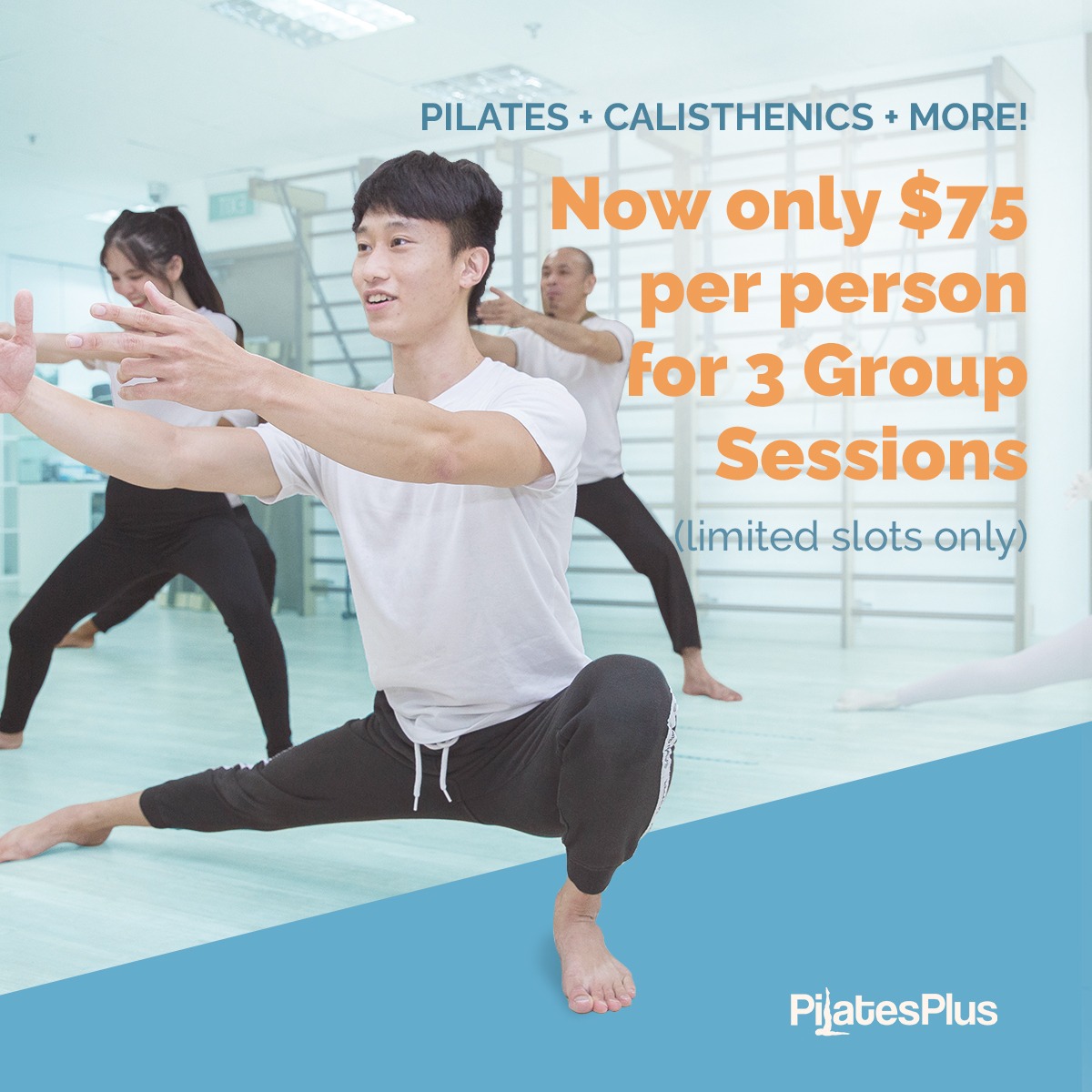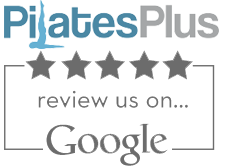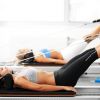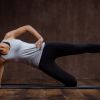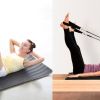PilatesPlus Blog
Home »
How Do You Really Get Better At Pilates Reformer Exercises!?
The Pilates Reformer exercises are unique, and they are hard to replicate without the machine. The combination of the springs, the moving carriage, and how you position your body on the Reformer gives you a very different experience with the movement. But because of this complexity, it can be overwhelming to understand the exercises even after several sessions.
After teaching Pilates for more than 20 years, I found a few things that work very well for my students to help them understand the exercises on the Pilates Reformer.
These are the six things you need to do in order for you to get better with the Reformer exercises:
- Understand how to properly align your body
- Improve your awareness without the Reformer machine
- Adjust the resistance or the intensity of the exercise
- Move slow and with purpose
- Coordinate the movement with the breathing
- Breakdown the movement into small components
I will explain to you one by one, so you will understand better what I mean.
1. Understanding proper alignment
Pilates Reformer exercises are specifically designed to work on realigning your joints and the way you move.
In the leg and footwork exercises for example, where you push the foot bar while you are lying down in a supine position. It is very important to understand that your toes, knees, and hips are properly aligned as you move back and forth.
Another angle you can look at these same exercises is at the hip and shoulder area. It is quite common for the hips and shoulders to be off-centered as you do the movement, which can compromise the benefit of the exercises.
You want to make sure that you are always properly aligned when doing Reformer exercises as you want to reinforce a better posture. Otherwise, you will end up reinforcing a bad alignment.
2. Awareness of the body without the Reformer machine
The Pilates Reformer is very effective in improving your flexibility, strength, and awareness. Still, sometimes it can be quite overwhelming, especially when you are new to the machine or learning a new exercise.
The best approach to work around this is to take the movement out of the Reformer and do part of the movement in a similar position. Then you can focus more on engaging the right muscles or doing the right sequence.
A good example is when you are doing the Seated Rowing exercise, which is a relatively long sequence to memorize. You can improve faster if you do the exercise seated on the floor and work on the arm movement sequence. Then go back to the Reformer once you have developed better awareness of the body in relation to the exercise.
3. Adjust the intensity or resistance
Reformer exercises can be quite challenging, and you need to learn how to adjust the intensity of the movement. You will end up compensating if you are struggling too much, which will develop into a bad habit in your practice.
On the other hand, doing an exercise at the same intensity for a long time will no longer stimulate your body to get better.
Depending on the movement, there are a couple of ways you can adjust the intensity of the reformer exercises.
- Changing the springs – this is pretty obvious, but one thing to take note of is that more springs don’t mean more intensity on all Reformer exercises. For example, when doing Pelvic press or Elephant stretch, lesser springs will intensify the movement. Compared to working on an arm press with straps in the supine position, adding more springs will make it harder.
- Decreasing or increasing the range of motion. The same with the springs; changing the range of different exercises can go either way. Abdominal exercises can be generally harder if you do a smaller range. It is good for you to explore multiple ranges to understand the movement deeper.
- Changing the setup of the machine or movement will also affect the intensity. In the Stomach Massage exercise, the height of the foot bar and where you sit on the carriage will play a big part in increasing or decreasing how hard the movement is.
4. Slow and purposeful movement
You should be familiar with this if you have been doing Pilates for some time, but sometimes we forget how important it is. Slow movements will also make it harder as it requires more control, and it gives you enough time to feel and check your form if you are doing it correctly.
Doing it slowly is not enough; understanding the purpose of the movement, knowing which muscles to contract, keeping your spine lengthened at all times, opening the shoulders back and down on arm exercises are among the few common things you have to remember as you do the movements.
5. Pair the movement with the breathing
Controlled Breathing exercises alone can do a lot of good things to the body. And incorporating the breath in your movement practice is one great way to still get the benefits of the breathwork, and it will also make your movement better.
Your breathing in Pilates will create a tempo in your movement to control the exercise and help activate the deeper core muscles.
Here is an article I wrote on Pilates breathing so you can understand more about it.
6. Breakdown the movements into small components
The best way to get better in any exercise is not just doing the same movement all the time but to break it down into several parts and practice them independently. Once you have fully understood all the components of the movement you are working on, you put them together.
In most arm exercises, for example, it is very common that your shoulder posture will be compromised as you do the movement. Instead of just correcting the shoulders while doing the actual exercise, you can step down, face the mirror, and do a separate drill just for your shoulders only. It can be a simple as shrugging up and down your scapula or protracting and retracting it. This will deepen your control on the specific muscles of your shoulders will give you a better chance of controlling it once you go back to practicing the whole exercise.
Pilates: Benefits Of Daily Reformer And Mat Exercises!
Once you have experienced a good Pilates session, whether, on the mat or Reformer, you’ll be hooked on it. The after-session sensation that it brings is just very different compared to other exercises you can do in the gym and regular fitness centers. That feeling of tallness, inner strength, improved flexibility, toned-abs, and soreness on the inner muscles that you don’t know existed is very addictive that you want to do the session again the next day.
Reformer Pilates exercises can be done daily. In fact, Pilates methodology that was originally founded by Joseph Pilates in the early 1900s is low impact, and low repetition type of workout was designed to be done every day to improve your breathing, concentration, alignment, coordination, the flow of movement, and centering.
We know that doing daily exercises is good for us. According to an article from the International Journey of Physical Education, Sports, and Health,
“Exercise not only makes you physically fitter but also improves your overall health and a general sense of well-being. Daily exercise can reduce stress and anxiety, boost happy chemicals, improve self-confidence, increase brainpower, sharpen memory, and increase our muscles and bones strength. Physical activity and exercise can have immediate and long-term health benefits. A minimum of 30 minutes a day can allow you to enjoy these benefits.”
Now that we know the benefits of doing regular exercises let us look at the added benefits of doing Pilates Mat and Reformer exercises daily.
Improve posture alignment
Our posture is greatly influenced by what we do regularly. That means that if you are sitting down hunching on your computer desk the majority of your time, the more your posture will hunch as well. So, if you want to correct your posture, doing a few exercise sessions a week may not be enough to establish a deeper correction.
Doing daily Pilates exercises will boost the correction of your posture as it will correct imbalances and strengthen the inner muscles of your joints and spine to make them stronger in a good alignment.
The Pilates Reformer machine will give you better feedback on how to hold your body alignment better which will help you actively correct your posture as you do the exercises.
Learn more exercises
Since you have more time to do your exercises, you will have more chances of learning new movements which will be an added benefit to your basic routine. The pilates method offers a wide range of exercises that you can do and each movement works differently on your body, so working on more variety of exercises will allow you to aim to more specific goals that you cannot achieve with lesser frequency sessions.
Polish your basics and develop a stronger foundation
“Perfect practice results in perfect movement”
Most people think of exercise as just an exercise rather than a skill to develop and practice. But this is far from the truth, especially with the Pilates methodology. The effectiveness of Pilates exercises depends on the quality of how you do the movements.
In fact, the more experience I have become, the harder the basic movements felt. This doesn’t mean that I got weaker, but instead, I am able to access more of the smaller muscles of my body, engage them more; thus it feels harder. This makes the movement even more beneficial to practice.
Core strength
There has been always a debate against daily core workouts especially in the gym setting where you’re doing hundreds of crunches and a variety of abdominal exercises all the way up to exhaustion. Here is an article from Livestrong where they discuss how you can approach daily core exercises.
Isolated abdominal exercises, in general, are not advisable to do daily as the same as any muscle in your body; your abs need a break. On the other hand, your core muscles are designed to work perpetually in conjunction with the rest of the body. Otherwise, you will not be able to hold an upright position.
Pilates exercises, though it is well known for their effectiveness in strengthening the core, don’t isolate the abdominal muscles as much, compared to common core strengthening movement. Most of the Pilates movements will employ the whole body to work together as one unit which is more functional and can be effectively done daily.
Prevents injuries and improve low back pain
Pilates exercises are done slowly and with full awareness of the movement. This makes the method very effective in preventing injuries as you are moving mindfully all the time. You will be able to move your body in better form and will transfer well into other forms of exercise or to your daily activities.
According to this study done by G. Maccagnano for the European Journal of physical and rehabilitation medicine, that there is a significant improvement of pain, disability, and physical and psychological perception of health in individuals who did the daily sessions of pilates.
Better body awareness
One of the main reasons I choose Pilates exercise as my base routine for sports and more demanding routine is how it can effectively develop my awareness. The slow and precise nature of the practice, coupled with the breathing, works really well to help me concentrate on my exercises.
This gives me a very good foundation to push further in my exploration to advanced bodyweight training like learning handstands as I can control my legs and pelvis better, even when upside down.
Decrease stress with breathwork
Focusing on the deep breathing work incorporated with the Pilates exercises works very well in reducing our stress. It releases the tension that you are unconsciously holding throughout the day.
Breathing has a big role in reducing stress; according to this article by Bruce Cryer, Rollin McCraty, and Doc Childre, on “Pull the Plug on Stress”, simply taking several slow, deep breaths can quickly diminish the feeling of stress.
Here is an article I wrote about Pilates breathing.
Better flexibility
Either you get tighter or more flexible on a daily basis. If you stretch or you’re moving your body in various ranges, then you are getting more flexible. If you are staying on your office chair or slumped on the sofa for hours, then you are on your way to becoming tighter.
Unfortunately, flexibility will be an ongoing battle, especially as we grow older, and doing daily Pilates exercises will help you work on your flexibility.
Better symmetry and balance
Pilates exercises on the Reformer are great to correct asymmetry in strength and alignment. The machine is designed to give you feedback if you are exerting more effort on one side. The shoulder pads, the straps, and the foot bar of the Pilates Reformer, coupled with slow and controlled movement, will force you to concentrate on evenly working the muscles in multiple directions.
You don’t have to be perfectly symmetrical with your entire body, but you cannot allow a significant imbalance between the front and back muscles or between your left or right sides. Slight imbalances overall are normal, but if you leave this out of control, it can cause one side to work too hard to compensate for the imbalance.
Enhance performance in sports and daily activities
Pilates exercises target the small stabilizer muscles of the body, which is seldom worked in high-intensity exercises. Most sports practices or even our daily activities will require us to use bigger muscle groups which is not a bad thing in general, but it will leave the smaller muscle groups left out.
Working these smaller muscles will stabilize the joints and will make you more efficient and balance when doing more demanding work. This would fill the gap between performing well and performing at your best.
Improves sleep
Doing a single session in Pilates will offer you more than just a core strength workout. It also works on relaxing and elongating your muscles and correcting imbalances which will make you rest better at night.
Conclusion
Pilates is a great exercise to do daily, but if you are new to Pilates, it might be a good idea to seek out guidance from an experience Pilates teacher to give you a well-balanced program. It is a good exercise on its own, but it will also be good to complement it with some bodyweight training exercises to have a more holistic approach to your training.
Pilates Singapore: What To Look For In A Pilates Studio!
Pilates classes and Pilates studios in Singapore must have more than tripled in the last 5 years. The popularity of the Pilates method has been steadily rising. With its aging population and many people putting more priority on health education, Pilates and fitness, in general, will continue to grow. The more the industry grows, the more commercial it will become. Choosing the right Pilates studio can be overwhelmingly confusing.
The best way to attend a Pilates class in Singapore is from a full Pilates studio furnished with all the necessary Pilates equipment that offers group and private session training. The classes have to be guided by Pilates teachers who are highly qualified and have years of experience in the Pilates practice.
We’ll try to go to more details on what you need to note in selecting the Pilates studio you will be joining.

What Pilates equipment the studio needs to have?
Though Pilates exercises can be done on the mat, there are movements that are uniquely designed and are more effective when done on the Pilates equipment. To get the full benefit of the Pilates method, the studio needs to have the necessary equipment to teach these exercises.
The Pilates Reformer
This is the most common equipment in the Pilates industry. It is very popular as Reformer exercises can be done in a group class setting. The Reformer machine has the size slightly smaller than a single bed, with only half of its length covered by a moving carriage.
The carriage has rollers underneath so it can slide forward and backward on the Reformer’s frame and is connected by springs (four or five springs of different tension) to the frame at the front. The carriage is connected to the back of the frame by straps that are looped in a pulley system. And at the front of the Reformer is a foot bar that can be adjusted in height.
This machine has a very interesting design that you can use in hundreds of ways and in many different positions. It can work on stretching your hips, spine, and arms. You can also do full-body strengthening exercises on the Pilates reformer. Here is an article I wrote about the things you can do on the Pilates Reformer.
Cadillac in Pilates
This machine is the centerpiece of a Pilates studio, not only because of its size but because of its beauty and, at the same time, scary-looking torture-like design. The Pilates Cadillac originated from a hospital bed that Joseph Pilates modified, so the patients in the hospital can exercise while recovering from their injuries.
It looks like a high bed that is supported by a stainless frame from the top and sides. Springs can be attached to the frames on both ends via hooks or sliding bars so you can adjust their position. You can also attach a trapeze at the top frame which you can use for hanging and doing different types of stretching.
The Pilates Cadillac is mainly used in a Private session setting and it is very effective to rehabilitate clients with back injuries and for older students who can’t go down safely onto the regular Reformer.
You can do a full-body workout on the Cadillac, and because of the top frame, you will have additional options to do hanging exercises as well.
Spine corrector
One of the best apparatus to loosen up the tightness in your back and strengthen your core muscles.
Aside from stretching the spine, you can do most of the classical mat exercises on the Pilates Spine Corrector. It is definitely a must-have for a Pilates studio.
Ladder barrel
A combination of a high barrel and a ladder, usually made of wood. The ladder barrel is a perfect apparatus to do ballet types of stretches, spine stretches, and core workouts.
The Wunda Chair
This is another piece of equipment where you can only find in a Pilates studio where it can work with your core, arms, legs, balance, and posture.
Foam roller/Release balls
The foam rollers and myofascial release balls are not really original Pilates apparatuses, but they have become very common in Pilates studios.
You can do stability, core, and balance work on the foam roller as well as releasing tight muscles, especially on the lower body.
The release balls are very effective in loosening up myofascial tightness, which is used in conjunction with stretching and mobility work.
Stallbar
This is a very versatile gymnastic equipment that can be used for a variety of exercises. It is commonly used to stretch and strengthen both the upper and lower body.
There have been images of some attachments on the stall bars which resemble the Pilates Reformer. This actually makes sense as Joseph Pilates has studied gymnastics before founding his own exercise method.
Balance equipment
Though balance equipment is not really part of Pilates, in my opinion, it should be included as one of the main fixtures in a Pilates studio.
Pilates exercises are very helpful to the aging population, and it makes sense to place balance work as a permanent part of the program.
Things you need to consider in selecting a Pilates teacher
Unlike working in a regular gym where you just go around the place and grab any dumbells or hop onto any cardio equipment, you need the guidance of a teacher to use the Pilates equipment.
5 years of teaching experience
Results in fitness won’t come quickly; some goals will take months or even years to achieve. It is the same with Pilates, especially when dealing with injuries. So, a Pilates teacher will need long enough experience to learn from students of different levels and backgrounds to really polish their teaching skills.
The teacher has to be practicing Pilates
There is something uniquely bad about the Pilates industry; that not all teachers are practitioners of Pilates. It is very common to study Pilates to get the certification but not really practice the method.
It has become very commercialized that you can even get certified to teach for just 3 days. Ensure that the teacher embodies the movement, truly practices the method, and not just pass the certification examination.
Qualifications and background
Aside from having a Pilates teacher certificate, having a rehabilitation background complements a lot in teaching Pilates as most people take Pilates exercise to recover from injuries.
Another thing you want to consider is for the teacher to have a more varied exercise background. The more the teacher is exposed to a variety of exercises, the better they can understand your goals and needs.
You can read more about us here.
Classes offered by a Pilates studio
A pilates studio should be offering both group classes on the mat and on the Reformer to make it a complete learning experience for the students in their training.
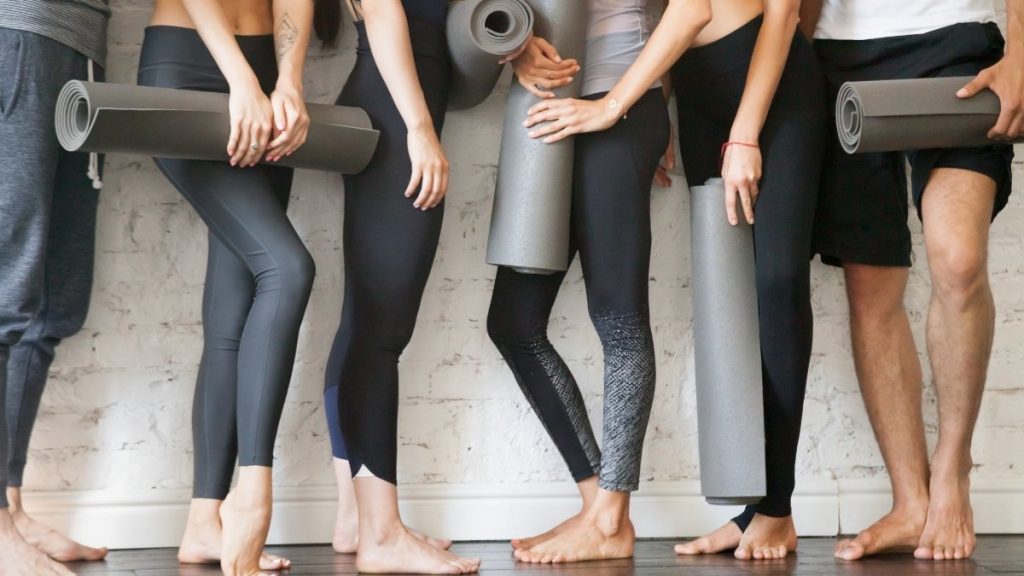
Mat class
A major part of Pilates practice is done on the mat. It is a very good system of exercise to work on the core, mobility training, and posture. Exercises done on the mat is good as you will develop better awareness in your body as you get to work with your own body with minimal distractions.
Pilates mat classes can be harder if you carry a little more body weight compared to somebody lighter, so it is not necessarily a beginner’s class, but it can be adapted as one.
You can reach a pretty high level even with just Pilates mat classes.
Look for a beginner-friendly class, so the pace will be slower for you to catch up in your first session.
Here is a 3 session introductory class that we offer for first-timers in our studio. You can use the credits to attend our mat classes and other non-reformer classes like the Calisthenics and Handstands class.
If you want to know more about the Pilates mat classes we offer at our studio, you can read this article here.
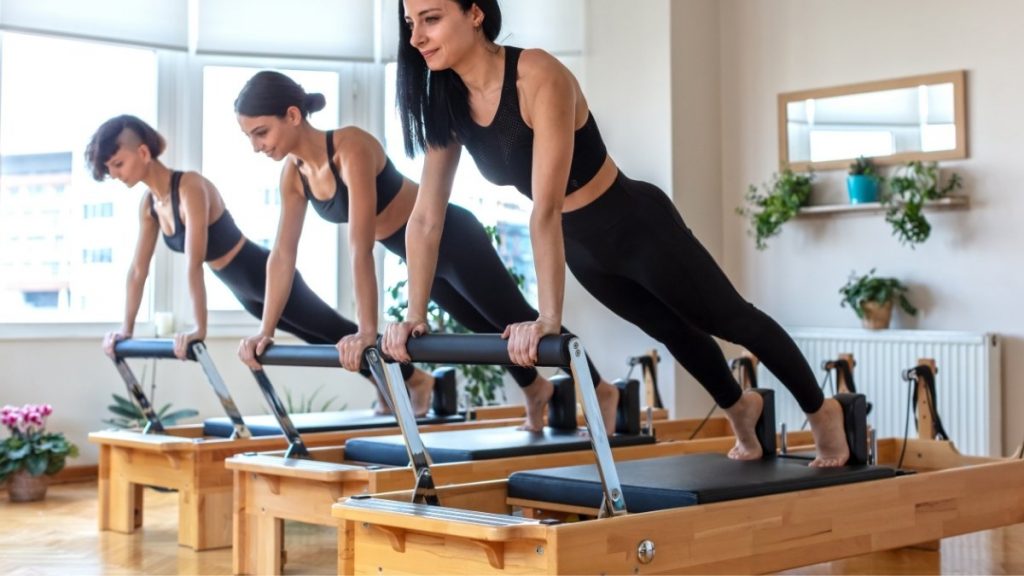
Reformer class
The group Pilates Reformer class offers a different role to your training. Using the machine will guide you with better alignment and better symmetry with your movement. It can make certain movements easier or harder, depending on how you set up the machine.
If you want to go deeper with your Pilates practice, working on the Reformer and other Pilates equipment should be a big part of your routine.
Look for a Reformer Introductory class where it covers the Fundamentals of how to use the machine or take a personal Pilates training for a few sessions. You will understand the method better, and you’ll be able to target your weak points early on in your training.
Here is a 3 session introductory package for our Reformer classes. All our classes are beginner-friendly, small size, and we can accommodate you even if it’s your first time doing Pilates.
Here is an article for more information about the Reformer classes that we do in the studio.
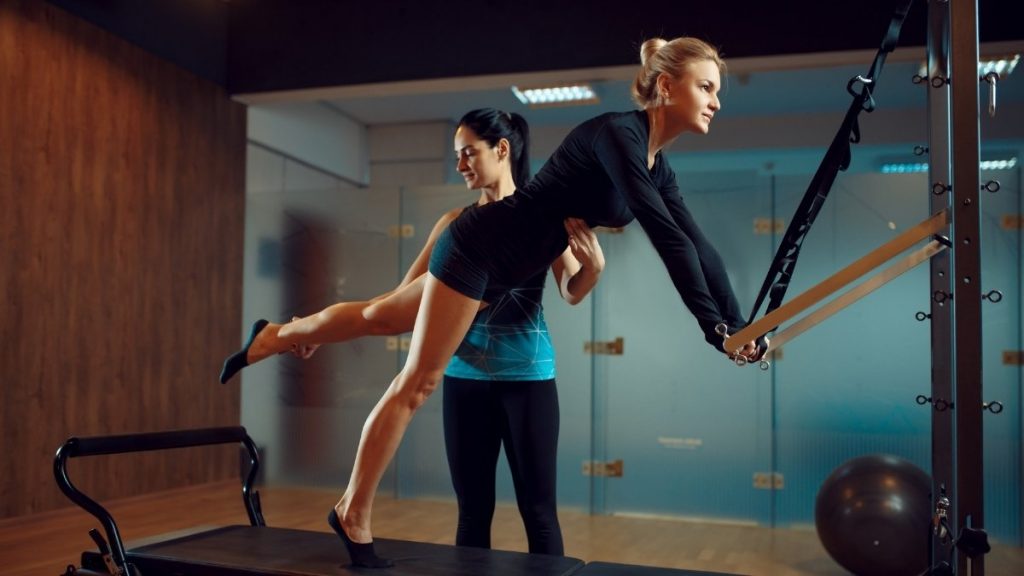
Private session training
The best way to learn Pilates is through Private sessions (one-to-one sessions), so the teacher can customize the program for your level. You’ll have the opportunity to fully utilize all the Pilates equipment that suits your needs and goals.
The progression of the exercises will be paced according to how fast you learn and improve with the movements, which is impossible to achieve in a group class.
One thing you have to take note of in taking personal training is to still be independent in doing the exercises yourself. It is good to mix it up by attending group classes or your own personal practice so you can get out of that dependency relationship with your teacher, which will not be good in the long run.
Contact us to schedule an introductory private session. In these 3 sessions, our experienced teachers will assess you and give you a customized program for your goals. You will also experience the different types of Pilates equipment that you can use for your program.
The Studio’s Pilates Method
There are different types of Pilates methodology that you can learn from. The major categories will be whether it is Contemporary, Classical, or a mix of both. All of the methods can be good for you, but it is good for you to be aware of what the Pilates studio is teaching, so you can also do your own personal research about the method if you want to take your Pilates study seriously.
At PilatesPlus Singapore, we are influenced greatly by the classical method plus some additional teaching by the Pilates masters that we have learned from like Ron Fletcher, Alan Herdman, Pat Guyton, and Michele Larsson.



